VENUS
 One of the few things that Mercury and Venus (Figure 6-
One of the few things that Mercury and Venus (Figure 6-
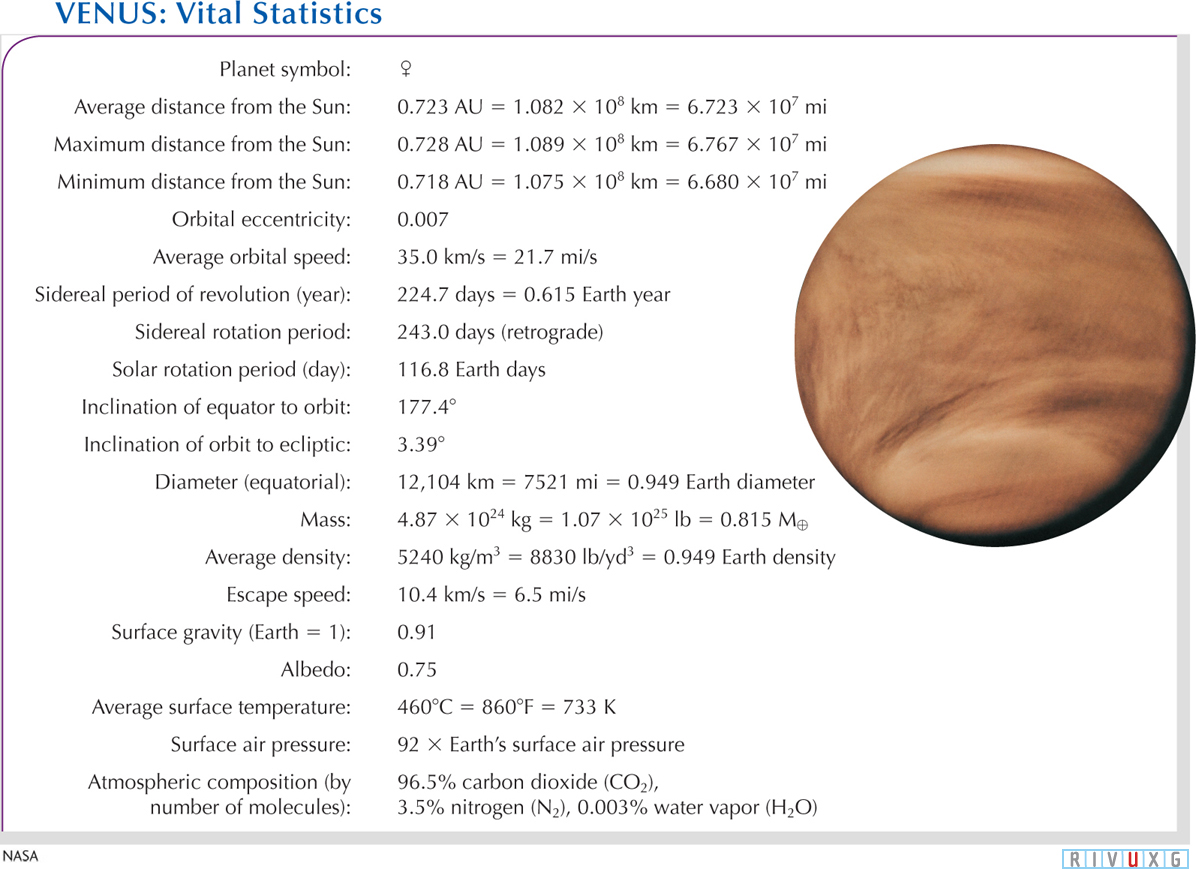
 Venus’s Vital Statistics Venus’s thick cloud cover efficiently traps heat from the Sun, resulting in a surface temperature even hotter than that on Mercury. Unlike Earth’s clouds, which are made of water droplets, Venus’s clouds are very dry and contain droplets of concentrated sulfuric acid. This ultraviolet image was taken by the Pioneer Venus Orbiter in 1979.
Venus’s Vital Statistics Venus’s thick cloud cover efficiently traps heat from the Sun, resulting in a surface temperature even hotter than that on Mercury. Unlike Earth’s clouds, which are made of water droplets, Venus’s clouds are very dry and contain droplets of concentrated sulfuric acid. This ultraviolet image was taken by the Pioneer Venus Orbiter in 1979.
6-15 The surface of Venus is completely hidden beneath a permanent cloud cover
At nearly twice the distance from the Sun as Mercury, Venus is often easy to view without interference from the Sun’s glare. At its greatest western elongation, Venus is seen high above the western horizon after sunset, where, like Mercury, it is often called the “evening star.” Conversely, high in the eastern sky before sunrise, it is called the “morning star.” The maximum elongation of Venus is always between 45° and 47°.
Venus is easy to identify because it is usually one of the brightest objects in the night sky. Only the Sun and the Moon outshine Venus at its greatest brilliance. Venus is often mistaken for a UFO because when it is low on the horizon, its bright light is strongly refracted by Earth’s atmosphere, making it appear to rapidly change color and position.
163
Unlike Mercury, Venus appears so bright in our sky because it is completely surrounded by light-
Building spacecraft whose technology could survive the descent into Venus’s atmosphere proved to be more challenging than anyone had expected. Finally, in 1970, the Soviet probe Venera (Russian for “Venus”) 7 managed to transmit data for 23 minutes directly from the Venusian surface. Soviet missions continued until 1985, measuring a blistering surface temperature of 750 K (890°F) and a surface air pressure of 92 atm, among other things. This value is the same pressure you would feel if you were swimming 0.82 km (2700 ft) underwater on Earth.
In contrast to Earth’s present nitrogen-
Soviet spacecraft also discovered that Venus’s clouds are confined to a layer that is 20 km (12 mi) thick and located 48 to 68 km (30 to 42 mi) above the planet’s surface. Above and below the clouds are layers of haze that are also 20 km (12 mi) thick. Beneath the lower level of haze, the Venusian atmosphere is clear all the way down to the surface.
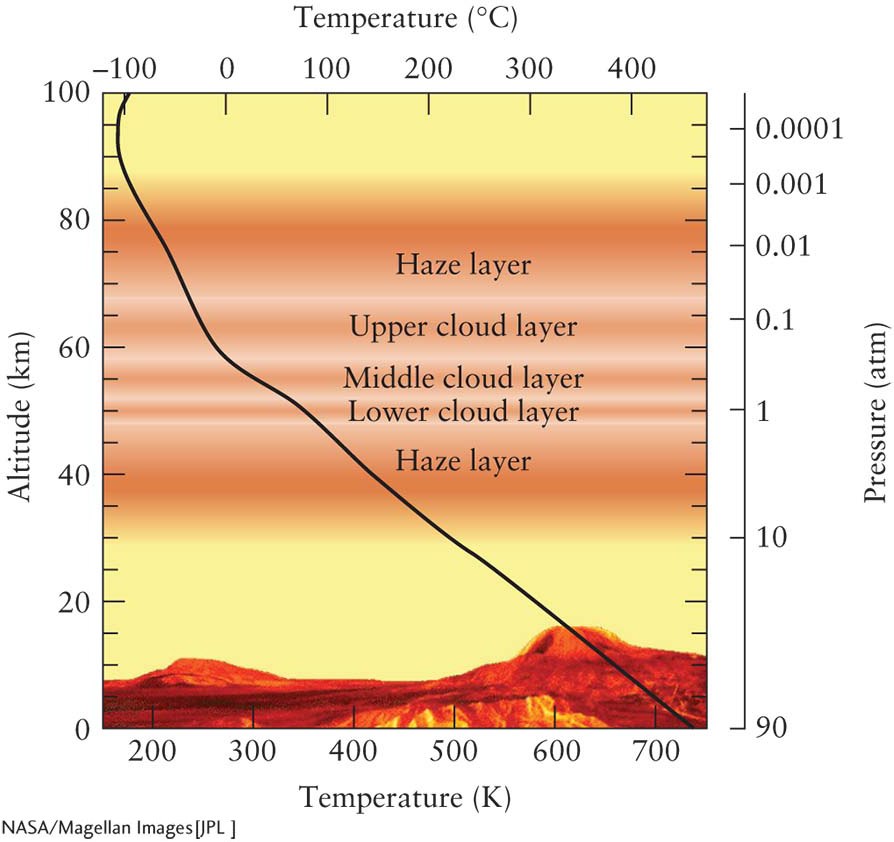
The results of the early probing of Venus’s atmosphere are summarized in Figure 6-
Unlike the clouds on Earth, which appear white from above, the cloud tops of Venus appear yellowish or yellow-
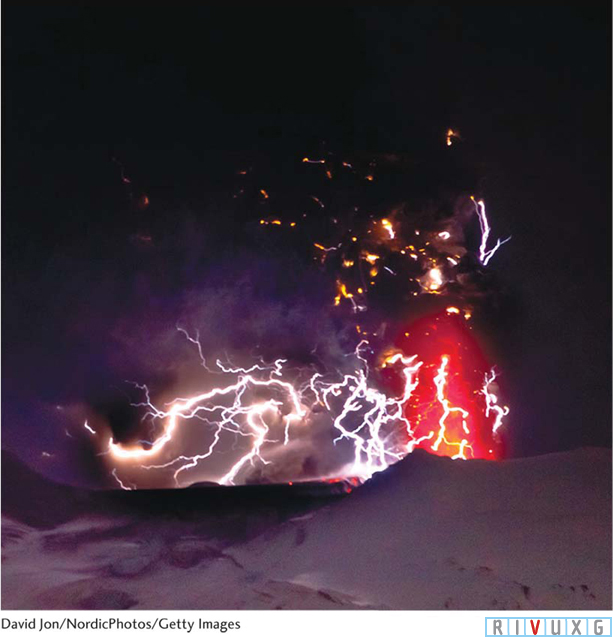
 Lightning on Earth This photograph of lightning generated by the Eyjafjallajökull volcano in Iceland in 2010 shows the phenomena that may have recently been observed on Venus.
Lightning on Earth This photograph of lightning generated by the Eyjafjallajökull volcano in Iceland in 2010 shows the phenomena that may have recently been observed on Venus.
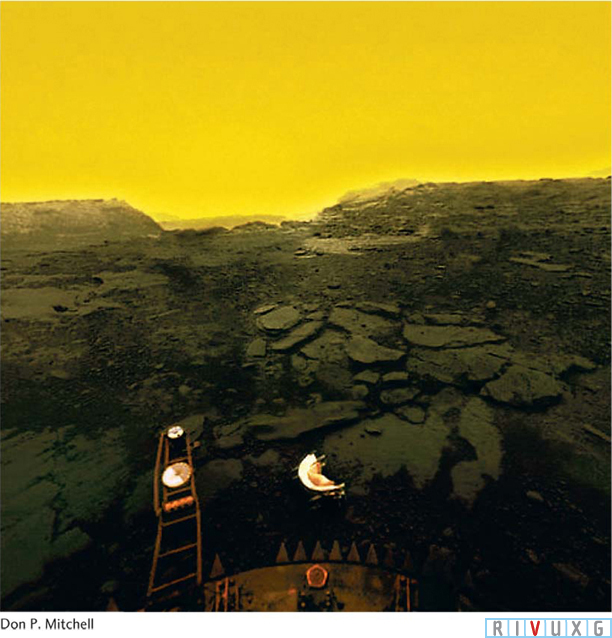
 The Venusian Surface The horizon and cloudy, carbon dioxide–
The Venusian Surface The horizon and cloudy, carbon dioxide–Focus Question 6-13
Why does the day have a yellow hue on Venus?
All of the major chemical compounds spewed into our air by Earth’s volcanoes have been detected in Venus’s atmosphere. Among these molecules are large quantities of sulfur compounds. Because many of these substances are very short-
164
6-16 The greenhouse effect heats Venus’s surface
At first, no one could believe reports that the surface temperature on Venus was higher than the surface temperature on Mercury, which, after all, is closer to the Sun. Setting aside this initial skepticism, astronomers found a straightforward explanation—
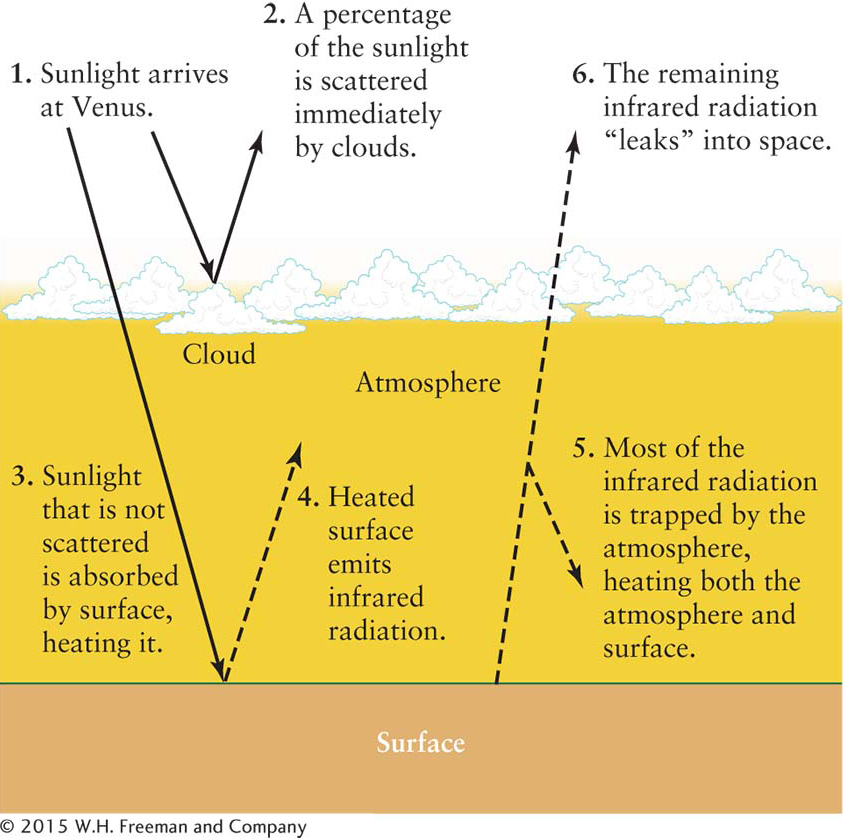
Carbon dioxide is responsible for the warming of Venus’s atmosphere. Like your car windows, carbon dioxide is transparent to visible light but absorbs infrared radiation. Although most of the visible sunlight striking the Venusian cloud tops is reflected back into space, enough light reaches the Venusian surface to heat it. The warmed surface, which is also heated from inside the planet, in turn, emits infrared radiation, which is absorbed by Venus’s carbon dioxide–
 Without the greenhouse effect, the surface of Venus would have a noontime temperature of 465 K (377° F). But with the greenhouse effect, that temperature is actually a sweltering 750 K (890° F), hotter than the hottest spot on Mercury! Indeed, Venus is the hottest of all four terrestrial planets. Furthermore, the thick atmosphere keeps the night side of Venus at nearly the same temperature, unlike the night side of Mercury, where the temperature drops precipitously.
Without the greenhouse effect, the surface of Venus would have a noontime temperature of 465 K (377° F). But with the greenhouse effect, that temperature is actually a sweltering 750 K (890° F), hotter than the hottest spot on Mercury! Indeed, Venus is the hottest of all four terrestrial planets. Furthermore, the thick atmosphere keeps the night side of Venus at nearly the same temperature, unlike the night side of Mercury, where the temperature drops precipitously.
165
This high temperature prevents liquid water from existing on Venus. Just like Earth, Venus was likely to have initially had water both in the debris from which it formed and from the impacts of ice-
6-17 Venus is covered with gently rolling hills, two “continents,” and numerous volcanoes
Soviet spacecraft that landed on Venus provided us with intriguing close-
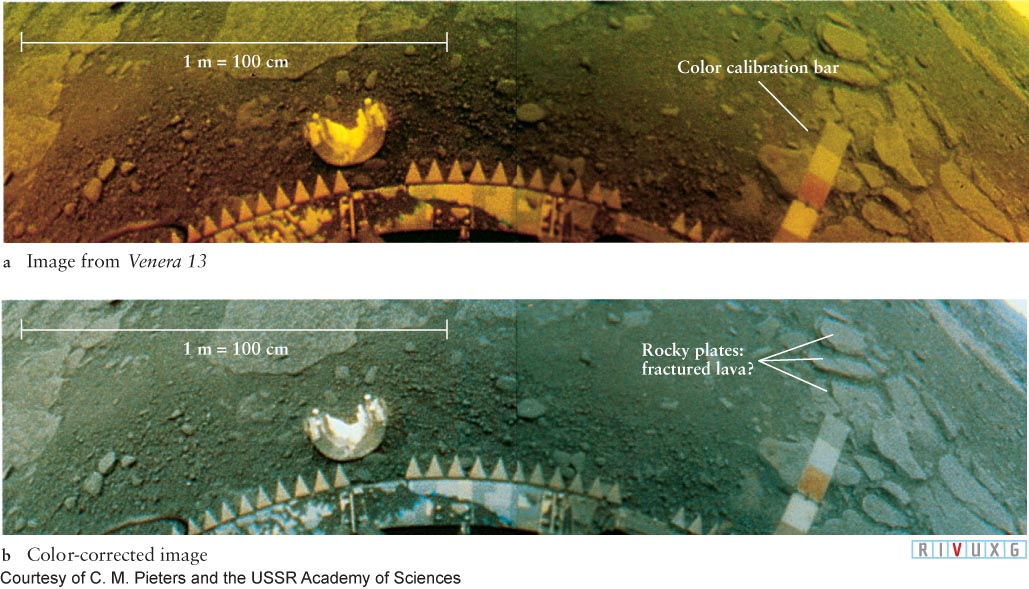
 Color Correcting Light on Venus’s Surface (a) This color photograph, taken by the Soviet Venera 13 spacecraft, shows rocks that appear orange because the light was filtered through the thick, sulfur-
Color Correcting Light on Venus’s Surface (a) This color photograph, taken by the Soviet Venera 13 spacecraft, shows rocks that appear orange because the light was filtered through the thick, sulfur-Focus Question 6-14
Where on Earth (besides in a greenhouse) does the greenhouse effect occur?
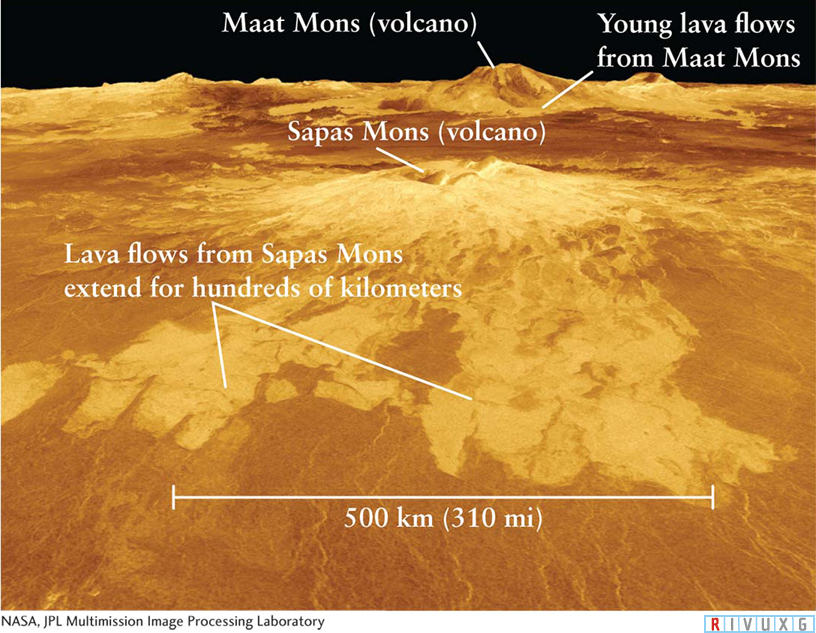
 A Venusian Landscape A computer combined radio images to yield this perspective view of Venus as you would see it from an altitude of 4 km (2.5 mi). The color results from light being filtered through Venus’s thick clouds. The brighter color of the extensive lava flows indicates that these flows reflect radio waves more strongly. The vertical scale has been exaggerated 10 times to show the gentle slopes of Sapas Mons and Maat Mons, volcanoes named for ancient Phoenician and Egyptian goddesses, respectively.
A Venusian Landscape A computer combined radio images to yield this perspective view of Venus as you would see it from an altitude of 4 km (2.5 mi). The color results from light being filtered through Venus’s thick clouds. The brighter color of the extensive lava flows indicates that these flows reflect radio waves more strongly. The vertical scale has been exaggerated 10 times to show the gentle slopes of Sapas Mons and Maat Mons, volcanoes named for ancient Phoenician and Egyptian goddesses, respectively.
The entire Venusian surface was mapped by the Magellan spacecraft, which arrived at Venus in 1990. While in orbit about the planet, Magellan sent radar signals through the clouds surrounding Venus. Like radar used by police, some of the radar signals bounced off Venus and returned to the spacecraft. By measuring the time delay of the radar echo, scientists determined the heights and depths of Venus’s hills and valleys. As a result, astronomers have been able to construct a three-
166
Venus is relatively flat compared to Earth. More than 80% of Venus’s surface is covered with volcanic plains and gently rolling hills created by numerous lava flows. Figure 6-
Global radar images revealed just two large highlands, or “continents,” rising well above the generally level surface of the planet (Figure 6-
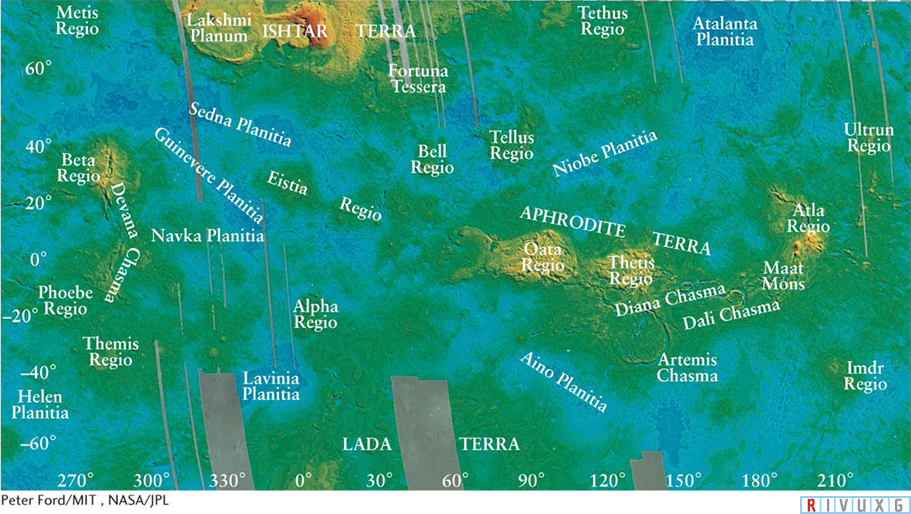
 A Map of Venus This false-
A Map of Venus This false-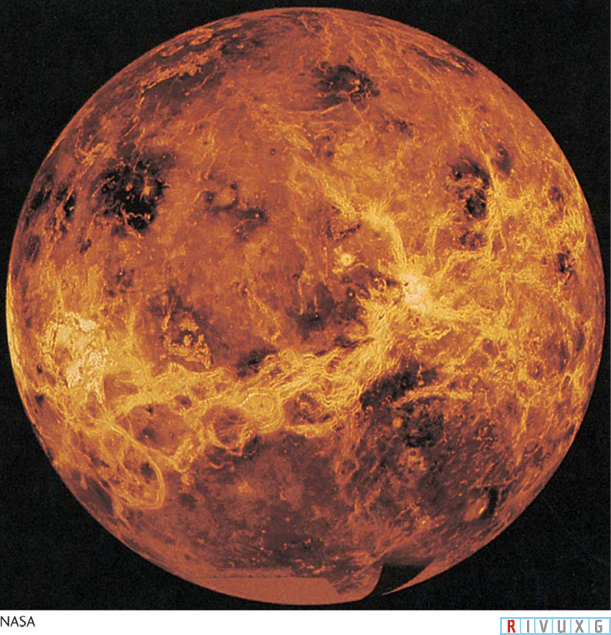
 A “Global” View of Venus A computer using numerous Magellan images creates a simulated globe. Color is used to enhance small-
A “Global” View of Venus A computer using numerous Magellan images creates a simulated globe. Color is used to enhance small-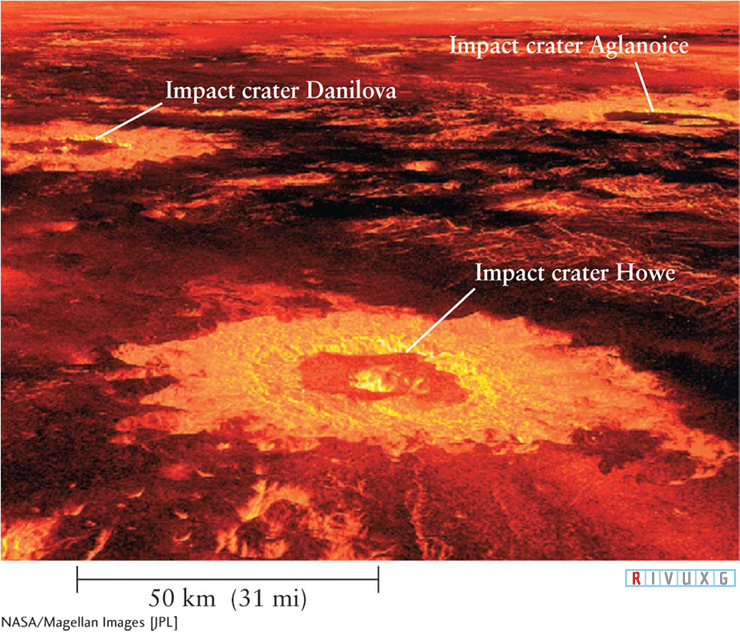
 Craters on Venus These three impact craters, with extensive ejecta surrounding each, are located on Venus’s southern hemisphere. They were imaged using radar by the Magellan spacecraft. The colors are based on the Venera images (see Figure 6-
Craters on Venus These three impact craters, with extensive ejecta surrounding each, are located on Venus’s southern hemisphere. They were imaged using radar by the Magellan spacecraft. The colors are based on the Venera images (see Figure 6-The larger Venusian continent, Aphrodite Terra (named after the Greek counterpart of the Roman goddess Venus), is a belt of highlands that straddles the equator. Aphrodite Terra is 16,000 km (10,000 mi) in length and 2000 km (1200 mi) wide, giving it an area about one-
Radar images reveal that Venus has more than 1600 major volcanoes and volcanic features and fewer than a thousand impact craters (Figure 6-
167
If we accept that the young Venus was cratered like every other solid object in the solar system, we still need to explain the low number of craters on it today. Earth removes impact craters as a result of both weathering and recycling the crust via plate tectonic activity. Neither of these effects is in play on Venus, which has typical wind speeds of less than 7 km/h (5 mi/h), no rain, and no large-
Without weather or tectonic plates moving relative to each other, how can the craters be erased? Several mechanisms to explain this are being explored. Most theories posit that the lack of surface motion has forced Venus’s crust to become thicker than Earth’s crust. In one theory, heat from radioactive elements inside the planet causes mantle convection without tectonic plate motion. The temperatures inside the planet eventually become high enough in the regions of rising mantle to create massive volcanoes out of which pour enormous amounts of magma that cover large areas of the surface. A variation of this theory proposes that the thickening crust is suddenly thinned from below by the horizontal convective motion of the mantle, like stripping layers off of plywood. When so thinned, heat is able to rise through the crust and cause many volcanoes to form.
Another theory proposes that, episodically, the one-
Focus Question 6-15
Why does little cratering occur on Venus today, even compared to the present low rate of cratering on our Moon?
In yet another theory, the mantle becomes so hot that large sections of the crust melt more or less simultaneously, destroying the old crust and its craters. Indeed, that theory has been expanded to periodic global meltdowns occurring every 700 million years or so. For all of these models, when enough heat is released from the planet’s interior, its surface once again solidifies and, with the possible exception of local volcanic activity, the crust rethickens.
The sulfur content of the air and the traces of active volcanoes on the surface are compelling indicators that, like Earth, Venus has a molten interior. Because the average density of Venus is similar to that of Earth, its core is predominantly iron. Currents in the molten iron should generate a magnetic field; however, other than the transient magnetic field detected by Venus Express, none of the spacecraft sent to Venus has detected one. In general, magnetic fields are created by rotation of currents (see Section 6-
168
That day is more unusual than just being much longer than ours. Unlike Earth and Mercury, Venus exhibits retrograde rotation, meaning that the direction of its rotation (clockwise as seen from space far above Earth’s North Pole) is opposite the direction of its orbit around the Sun, which is counterclockwise as seen from the same vantage point. As a result of its retrograde rotation, sunrise on Venus occurs in the west and sunset in the east.
Another perspective on its retrograde rotation is that Venus’s rotation axis is tilted more than 177°, compared to Earth’s 23½° tilt. That means that Venus’s north pole is on the other side of that world than Earth’s north pole. Because Venus’s axis is within 3° of being perpendicular to the plane of its orbit around the Sun, the planet has no seasons. Although we do not know the cause of Venus’s retrograde rotation, one likely explanation is that a monumental impact flipped the rotation axis early in the planet’s existence.